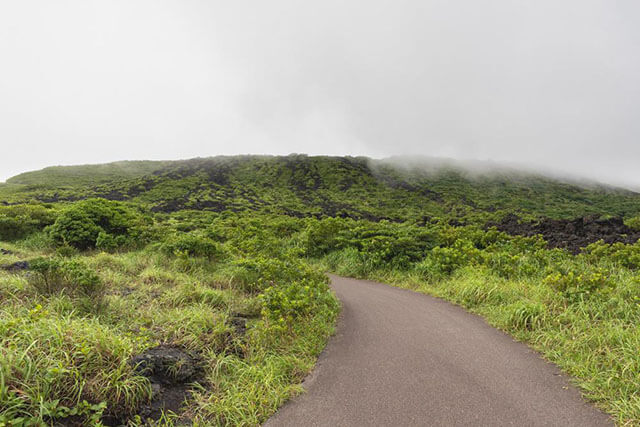
Mt. Mihara rises 758 meters above the small Izu Oshima island. The active volcano is the focal point of the island and known for its traditional folklore and modern presence in popular culture, famously featured in “The Return of Godzilla” and “The Ring”. Visitors can hike to the summit using different trails for each difficult level. The trails cover a large amount of natural landscapes, from foggy rainforests to a desert-like atmosphere created from recent eruptions.
-
![]()
A part of the Izu Hakone National Park, which encompasses natural landmarks such as Mt. Fuji, Mt. Mihara is known for its hikes and open crater. There are a variety of hiking trails offered, ranging from an easy one hour stroll to a half day trek. The popular 45 minute trail “Ohachimeguri” leads hikers to a volcanic vent while the “Urasabaku” trail features a desert of igneous rock. The desert is in fact, a designated desert, despite being a quick walk away from a foggy forest. On the “Urasabaku” trail, hikers can walk up to the caldera, or the bowl like hollow created from a large eruption. A hike around the caldera rewards trekkers with a vast view of Oshima. On clear days, Mt. Fuji and the rest of the Izu Hakone Park can be seen.
![]()
Most hikes only last about two to three hours round trip. While Mt. Mihara is a mountain, the trail are not steep and can be easily climbed without strenuous effort. Most hikers leisurely mosey along the path to take in the vibrant and divergent nature. Some of the trails are paved and the roads leading up to the summit are well marked, making them easy to follow. However, heavy fog can compress vision. Be sure to head out on a clear day for the easiest visibility and best views.
![]()
While Mt. Mihara is a popular place for hiking, it is still an active volcano. Hikers need to take caution against possible eruptions. Oshima’s meteorological board is very active and warns visitors and residents of any upcoming events. Helmets are available for lend from the observatory and summit entrance. Most hikers don’t use the helmets but those looking for extra protection might appreciate the caution. There are also shelters along the hiking trails in the case of an unpredicted eruption. The observation deck also acts as a shelter. Luckily, the volcano erupts every century or so.
![]()
![]()
The most recent eruption was in 1990 but the largest recent eruption was on November 1986. The intense lava flow has since hardened into black, sharp rocks located around the summit and the island. Dabblers in geology can marvel at the large amounts of igneous rock that have created a unique and spooky atmosphere around the volcano. These rocks can also be found around the island, quite far from their initial starting point. Recently, flora has been popping up between the rocks, showing signs of striving life.
![]()
Mt. Mihara can be accessed from the Miharayama Onsen. Buses also run from the ferry ports throughout the year. But, if traveling out of season, a rental car is recommended for the best convenience.







 Go here
Go here





